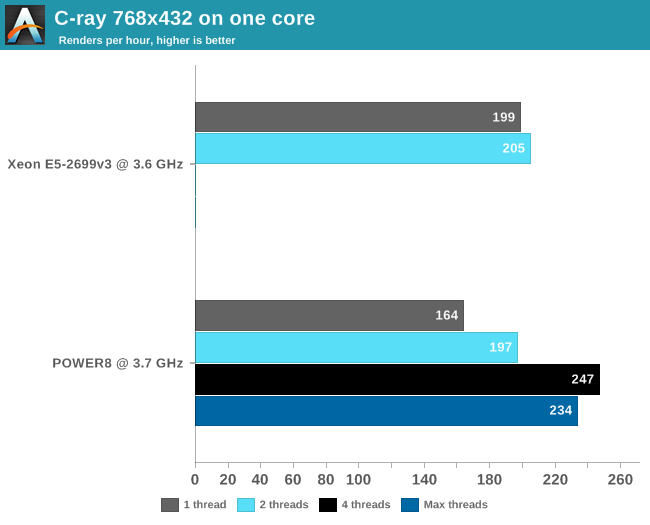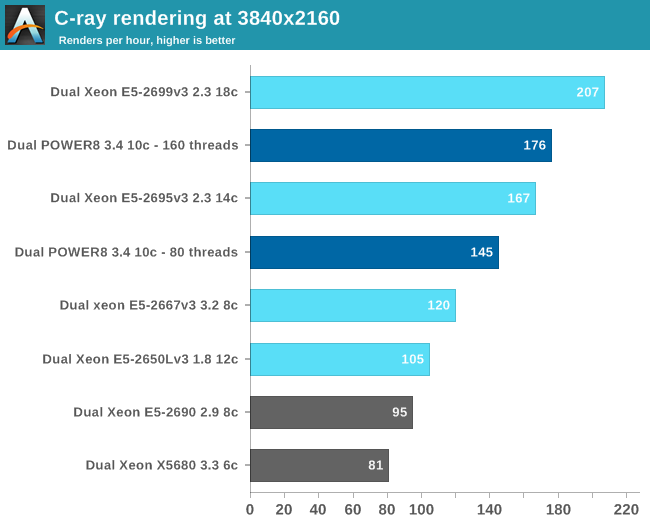The IBM POWER8 Review: Challenging the Intel Xeon
by Johan De Gelas on November 6, 2015 8:00 AM EST- Posted in
- IT Computing
- CPUs
- Enterprise
- Enterprise CPUs
- IBM
- POWER
- POWER8
Floating Point: C-ray
Shifting over from integer to floating point benchmarks we have C-ray. C-ray is an extremely simple ray-tracer which is not representative of any real world raytracing application. In fact, it is essentially a floating point benchmark that runs out the L1-cache. Luckily it is not as synthetic and meaningless as Whetstone, as you can actually use the software to do simple raytracing. That is not the kind of benchmark we like to use for the evaluations of server CPUs, but since our first efforts to port some of our favorite applications to OpenPOWER failed, we settled for something easier. We knew we would have the POWER8 system only for a few weeks, so we had to play it safe.
First we compiled the C-ray multi-threaded version with -O3 -ffast-math. To understand the CPU performance better, we limited C-ray with taskset to one or two threads (CPU 0 and 18) on the Haswell-based Xeon and one to eight threads on the POWER8. We also kept the output resolution at 768x432 to keep the render times in check. The "sphfract" file was used as input.

Real floating point intensive applications tend to put the memory subsystem under pressure, and running a second thread makes it only worse. So we are used to seeing that many HPC applications performe worse with multi-threading on. But since C-ray runs mostly out of the L1-cache, we get different behavior. Still, 8 threads of floating action seem to be too much: the POWER8 delivers the best FP performance at 4 threads. At this point, the POWER8 core is able to deliver 20% higher floating point performance than the Haswell Xeon.
Next we used all 160 (20 x 8 threads SMT) or 72 (36 x 2 threads SMT) threads and increased the resolution to 3840x2160.

With a core count that is 80% higher, there is nothing stopping the Xeon E5-2699 v3 from taking the top spot. Still, the POWER8 delivers solid performance and outperforms the slower Xeon E5-2695 v3 by 5%. Although the real world relevance of this benchmark is small, we now have an idea of how good the "basic FP" performance is. Otherwise in real world applications, the use of AVX-2/VSX and the available bandwidth will play a role.










146 Comments
View All Comments
extide - Friday, November 6, 2015 - link
No he meant that in a lot of the european countries they use the dot as a comma, so it would be 50.000 to mean 50 thousand.Murloc - Sunday, November 8, 2015 - link
the international system dictates that , and . are the same thing, and as a separator you should use a space.In many countries in Europe, ' is also used. That's fine too as there is no ambiguity.
Using . and , for anything that is not the decimal separator in international websites just creates confusion imho.
I guess AT doesn't have a style book though.
duploxxx - Friday, November 6, 2015 - link
nice review.but Xeon is not 95% of the market. AMD is still just a bit above 5% on its own. so it deserves a bit salt :) not to mention the fact that competition is good for all of us. if reviewers continue like this all narrowed readers will think there is no competition.
silverblue - Friday, November 6, 2015 - link
I'm left wondering what a Steamroller-based 16+ core CPU would do here, considering multithreading is better than with previous models. Yes, the Xeons have a large single-threading lead, but more cores = good in the server world, not to mention that such a CPU would severely undercut the price of the competition.Shame it isn't ever going to happen!
lmcd - Friday, November 6, 2015 - link
Or even an Excavator! It's a shame AMD didn't just keep Bulldozer developing internally until at least Piledriver, and iterate on Thuban.Kevin G - Saturday, November 7, 2015 - link
AMD killed off both Streamroller and Excavator chips early on as the Bulldozer and Piledriver chips weren't as competitive. More importantly, OEMs simply were not interested even if those parts were upgrades based upon existing designs. Thus the great AMD server drought began as they effectively have left that market and are hoping for a return with Zen.Also I should point out that Seattle, AMD's first ARM based Opteron has yet to arrive. This was supposed to be out a year ago and keep AMD's server business going throughout 2015 during the wait for Zen and K12 in 2016. Well K12 has already been delayed into 2017 and Seattle is no where to be found in commercial systems (there are a handle of Seattle developer boards).
JoeMonco - Saturday, November 7, 2015 - link
When you account for only 5% of the market while the other side commands 95%, you aren't really much of a credible competitor.xype - Sunday, November 8, 2015 - link
That’s not always correct, though. You can have 5% of the market and 20% of the profits, for example, which would put you in a way better position than your competitors (because only a small increase in market share would pay big time).Murloc - Sunday, November 8, 2015 - link
that applies more to consumer products, e.g. apple.dgingeri - Friday, November 6, 2015 - link
I've been dealing with IBM Power based machines for 5 years now. Such experience has only given me a major disdain for AIX.I do NOT advise it for anyone. It sucks to work on. There is a certain consistent, spartan logic to it, but it is difficult to learn, and learning materials are EXTREMELY expensive. I never liked the idea of paying $12,000 for a one week class that taught me barely a tenth of what I needed to know to run an AIX network. (My company paid for the class, but I could not get them to pay for the rest of them, for some reason.) This makes people who can support AIX extremely expensive to employ. Figure on paying twice the rate of a Windows admin in order to employ an AIX admin. Then there is the massive expense of maintenance agreements. Even the software only maintenance agreement, just to get patches for AIX, is $4000 per year per system. They may be competitive in cost up front, but they drain money like vampires to maintain.
Even the most modern IBM Power based machine takes 20-30 minutes to reboot or power up due to POST diagnostics. That alone is annoying enough to make me avoid AIX as much as I can.